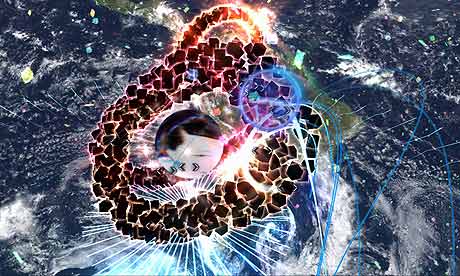
Have you ever taken a Spirograph to a rave? No? Then hold tight to your coloured Biros and pack your glosticks, because that's very much what on-rails shape-shooter Child of Eden is like – and it's a blissful, beautiful thing to play.
It's pegged as a spiritual successor to 10-year-old trancey lightshow Rez, and in terms of gameplay, it's virtually a remake. That doesn't mean there's anything tired or predictable about it, though; that decade has been kind to designer Tetsuya Mizuguchi's ideas, and it feels as though technology has finally fallen into step with his curious mix of gunplay and rhythm action.
Levels consist of swirling corridors out of which malevolent shapes rush you. These are the "infected" and it's your job to cleanse them. Thanks to Kinect, you do this by swishing and jabbing to lock onto targets and activate your lasers.
The option to revert to the control pad is there, but it's hard to know why you'd want to when the motion control feels so good, and so right. Kinect can be floaty and frustrating, but that's not an issue here at all. Partly, that's because the gesture-control is sharply implemented and satisfyingly instinctive. And partly, it's because the game sucks you right in.
This is despite an opening that looks like a high-end shampoo commercial, and a fairly disposable story – Lumi is a human intelligence struggling to be born inside the internet (that's Eden), and you have to defeat the virus that threatens her. That's all, by the way.
What matters is that this throws you into a world of glittering geometry, soundtracked by the ecstatic music of the band Genki Rockets. Even if you start out resistant to the concept, it's nearly impossible not to become absorbed, because the game is designed to make you a part of it. Every shot adds another beat to the music; every arm sweep, another explosion of colour and light.
As you approach the end of a level (there are five in all), everything comes together. The soundtrack pulses to joyful climax, the visuals dazzle, and you're there, arms in the air, making it all happen. When you triumph and the music drops away to a gentle, satisfied rhythm, it feels like you've really accomplished something.
Calling something an "experience" rather than a "game" is generally one of the nobbier cards a reviewer can play, but there really is some truth to it here. Child of Eden even offers a no-damage difficulty level that encourages you to play for pleasure rather than play to win – and it's not just a patronising sop to the aiming-impaired, but a different way of being in the world, and satisfying in its own right.
There's a lot that's not included in Child of Eden, and it would be easy to miss the game's point if you wanted to. It isn't about character or narrative. It doesn't make you feel like a mighty, hooah-ing bullet sponge. You don't solve puzzles or collect items (barring the unlockable backgrounds and videos you can win as you progress).
That's fine – all of those needs are well served elsewhere on the games shelf. In Child of Eden, you just do, and out of that sleek simplicity comes a game of giddying depth and potentially endless replayabilty, because every time you take on a level, the interaction of visuals, sound and motion makes it something slightly different. The best thing you can do is let the music take you with it.
• Game reviewed on Xbox Kinect

